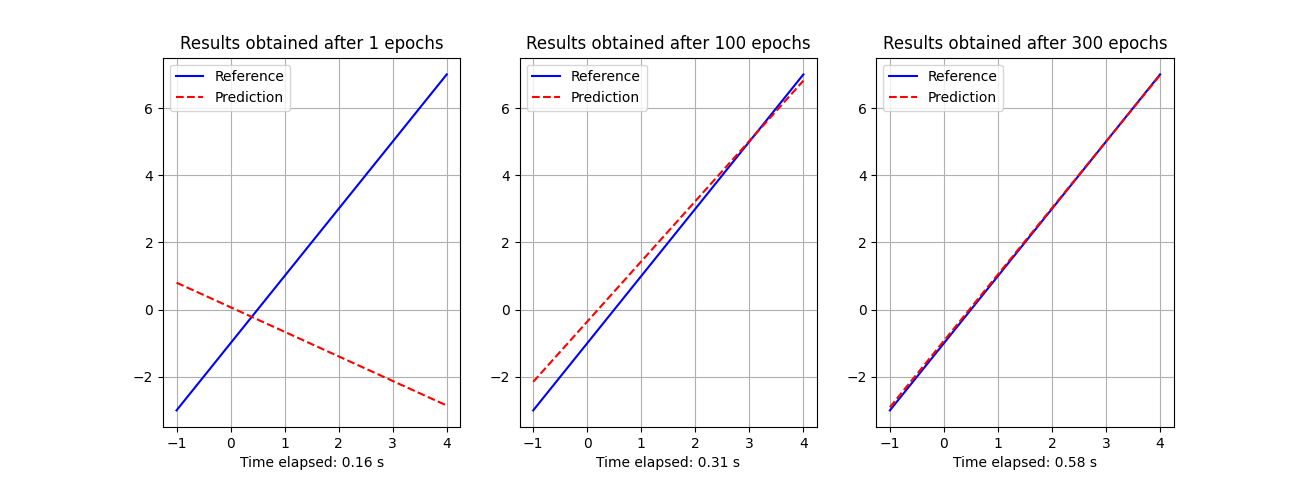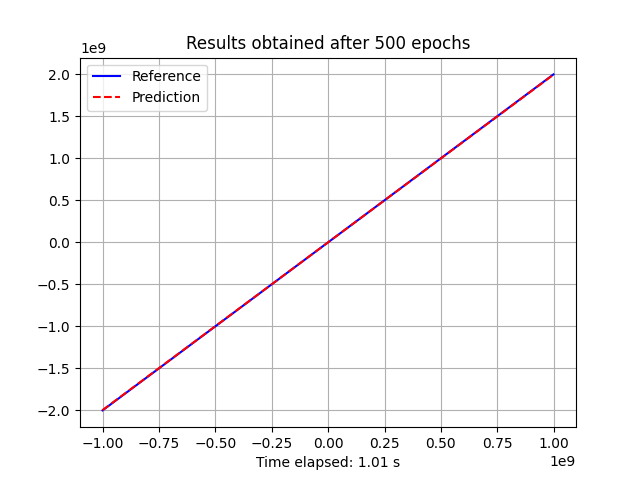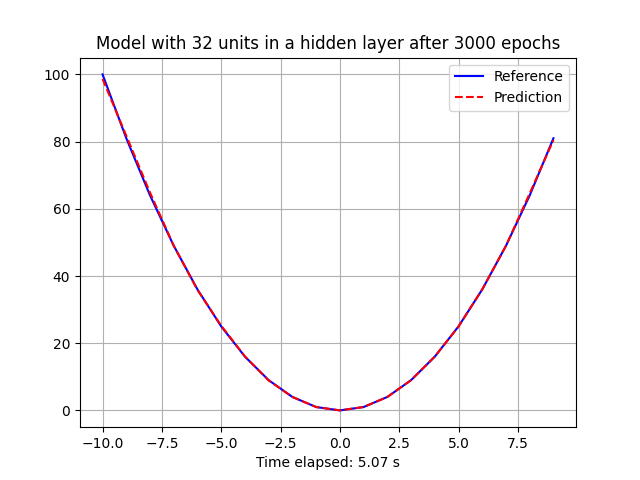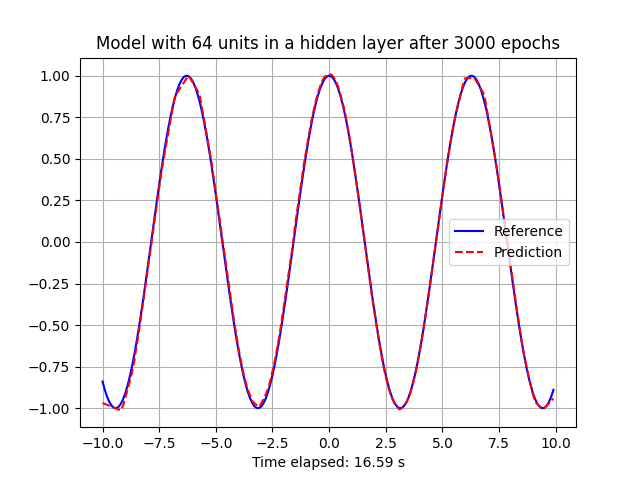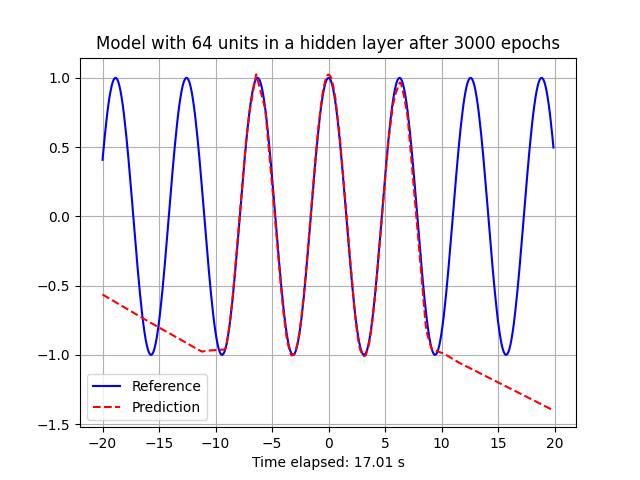This project contains a few basic neural network examples inspired while I was following Laurence Moroney's Introduction to TensorFlow for Artificial Intelligence, Machine Learning, and Deep Learning course in Coursera.
In particular, the examples come from his lecture on "the Hello World of neural networks" in which he shows probably the simplest example of an actual working neural network that performs a linear regression.
This example uses a neural network with only one neuron to perform a linear regression even using the same numbers as in Coursera's lecture.
from hello_world.models import LinearRegressionModel
xs = [-1.0, 0.0, 1.0, 2.0, 3.0, 4.0]
ys = [-3.0, -1.0, 1.0, 3.0, 5.0, 7.0]
linear_regression = LinearRegressionModel(xs, ys)
ps = linear_regression.model.predict([10.0]) # 18.98 ~ 19.00The following code shows how we can plot the reference data against the data generated by our model so that we can see how good it fits.
import time
import numpy as np
from hello_world.models import LinearRegressionModel
from hello_world import plotter
# Prepare the training data
xs = np.array([-1.0, 0.0, 1.0, 2.0, 3.0, 4.0], dtype=float)
ys = 2 * xs - 1
# Train our neural network
start = time.time()
linear_regression = LinearRegressionModel(xs, ys)
elapsed = time.time() - start
# Use the trained network to predict outputs
ps = linear_regression.model.predict(xs)
# Plot the results
title = "Results obtained after {} epochs".format(
linear_regression.epochs)
x_label = "Time elapsed: {:.2f} s".format(elapsed)
figure = plotter.plot(xs, ys, ps, title, x_label)
figure.savefig("images/linear-regression-with-500-epochs.png")As the image below shows, the results are insanely accurate but...
- what does it mean "500 epochs"?
The LinearRegressionModel class that we have been testing so far is set to use 500 epochs unless it's called to with a specific value. Let's now call it with different values and see how it affects the predictions.
import time
import numpy as np
from hello_world.models import LinearRegressionModel
from hello_world import plotter
def get_plot(epochs):
# Prepare the training data
xs = np.array([-1.0, 0.0, 1.0, 2.0, 3.0, 4.0], dtype=float)
ys = 2 * xs - 1
# Train our neural network
start = time.time()
linear_regression = LinearRegressionModel(xs, ys, epochs=epochs)
elapsed = time.time() - start
# Use the trained network to predict outputs
ps = linear_regression.model.predict(xs)
# Prepare the plot
title = "Results obtained after {} epochs".format(
linear_regression.epochs)
x_label = "Time elapsed: {:.2f} s".format(elapsed)
return {"xs": xs, "ys": ys, "ps": ps, "title": title, "x_label": x_label, "y_label": None}
# Plot the results
plots = []
plots.append(get_plot(1))
plots.append(get_plot(100))
plots.append(get_plot(300))
figure = plotter.multiplot(plots)
figure.savefig("images/linear-regression-with-1-100-and-300-epochs.png")As the following stack of plots show, the more epochs, the more the predictions get closer to the reference.
import time
import numpy as np
from hello_world.models import LinearRegressionModel
from hello_world import plotter
# Prepare the training data
xs_train = np.array([-1.0, 0.0, 1.0, 2.0, 3.0, 4.0], dtype=float)
ys_train = 2 * xs_train - 1
# Train our neural network
start = time.time()
linear_regression = LinearRegressionModel(xs_train, ys_train)
elapsed = time.time() - start
# Use the trained network to predict outputs
xs = np.arange(-1000000000, 1000000000, 1000000, dtype=float)
ys = 2 * xs - 1
ps = linear_regression.model.predict(xs)
# Plot the results
title = "Results obtained after {} epochs".format(
linear_regression.epochs)
x_label = "Time elapsed: {:.2f} s".format(elapsed)
figure = plotter.plot(xs, ys, ps, title, x_label)
figure.savefig("images/linear-regression-far-away-from-the-reference.png")When you look at the following chart, pay attention to the 10e9 labels as they indicate that we are now asking the model to give us values that range from -1 to +1 (English) billions. That's not bad!
Two Hidden Layers
As we may imagine, the linear regresion model won't help us learning non linear functions. This means that our neural network isn't yet able to learn a simple quadratic function like
In order to solve this, we have available a second model that also works with a single input and a single output, but contains two hidden intermediate layers.
As the code below shows, the number of units in each of the hidden layers can be set using the hidden_units argument.
import time
import numpy as np
from hello_world.models import *
from hello_world import plotter
# Prepare the training data
xs = np.arange(-10, 10, dtype=float)
ys = xs**2
# Train our neural network
start = time.time()
hidden_layer = TwoHiddenLayerModel(xs, ys, epochs=3000, hidden_units=32)
elapsed = time.time() - start
# Use the trained network to predict outputs
ps = hidden_layer.model.predict(xs)
# Plot the results
title = "Model with {} units in a hidden layer after {} epochs".format(
hidden_layer.hidden_units,
hidden_layer.epochs)
x_label = "Time elapsed: {:.2f} s".format(elapsed)
figure = plotter.plot(xs, ys, ps, title, x_label)
figure.savefig("images/quadratic-approximation-using-two-hidden-layers.png")Finally, let's test the two layers against a periodic function like
import time
import numpy as np
from hello_world.models import *
from hello_world import plotter
# Prepare the training data
xs = np.arange(-10, 10, .1, dtype=float)
ys = np.cos(xs)
# Train our neural network
start = time.time()
hidden_layer = TwoHiddenLayerModel(xs, ys, epochs=3000, hidden_units=64)
elapsed = time.time() - start
# Use the trained network to predict outputs
ps = hidden_layer.model.predict(xs)
# Plot the results
title = "Model with {} units in a hidden layer after {} epochs".format(
hidden_layer.hidden_units,
hidden_layer.epochs)
x_label = "Time elapsed: {:.2f} s".format(elapsed)
figure = plotter.plot(xs, ys, ps, title, x_label)
figure.savefig("images/sinusoidal-approximation-using-two-hidden-layers.png")As you can see, a pretty simple neural network can easily handle this. At least for ranges of points that are close to the points it was trained for.
If you read all this, you probably want to see these algorithms limitations. Actually, if can easily change the previous code to make predict some points that are further than the points we included during the training.
import time
import numpy as np
from hello_world.models import *
from hello_world import plotter
# Prepare the training data
xs_train = np.arange(-10, 10, .1, dtype=float)
ys_train = np.cos(xs_train)
# Train our neural network
start = time.time()
hidden_layer = TwoHiddenLayerModel(xs_train, ys_train, epochs=3000, hidden_units=64)
elapsed = time.time() - start
# Use the trained network to predict outputs
xs = np.arange(-20, 20, .1, dtype=float)
ys = np.cos(xs)
ps = hidden_layer.model.predict(xs)
# Plot the results
title = "Model with {} units in a hidden layer after {} epochs".format(
hidden_layer.hidden_units,
hidden_layer.epochs)
x_label = "Time elapsed: {:.2f} s".format(elapsed)
figure = plotter.plot(xs, ys, ps, title, x_label)
figure.savefig("images/sinusoidal-approximation-far-from-training-points.png")As you can see, the network won't have a clue about what we are asking.
This project was written with Poetry. The following instructions should be sufficient for you to start using it.
git clone https://github.com/elcapo/hello_world.git
cd hello_world
poetry installNote that you'll need to install git, python and poetry to get this working.
Once installed, use Poetry's shell to interact with the package.
poetry shellTo run the tests, use PyTest from your shell.
pytest -v
# or
poetry run pytest
